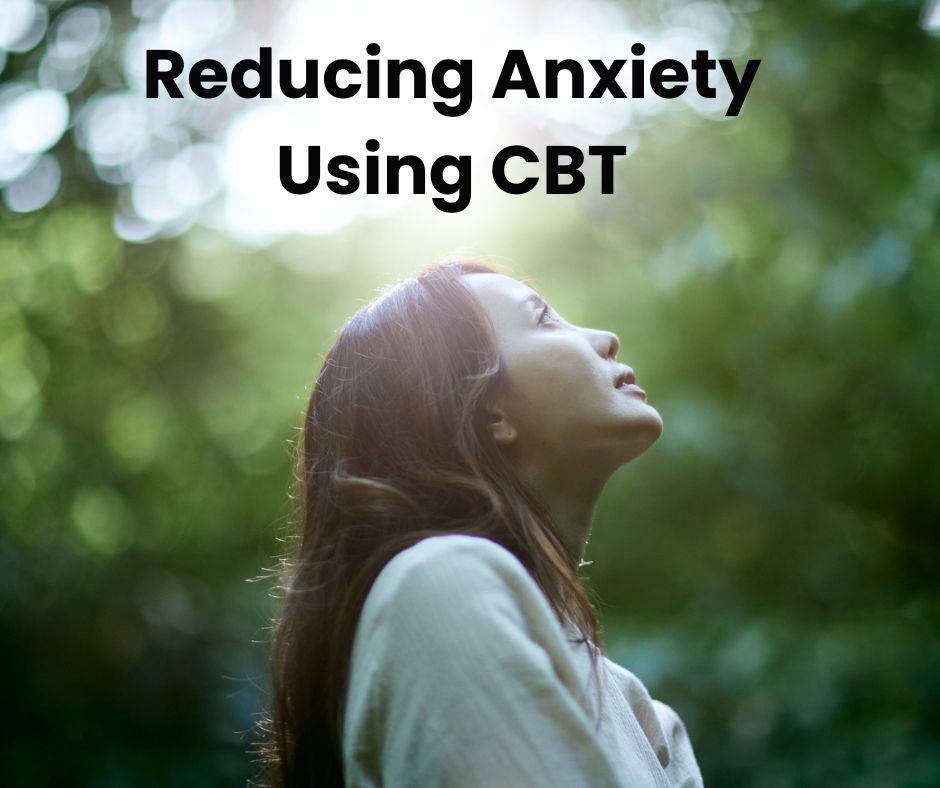Reducing Anxiety Using CBT
Reducing Anxiety Using CBT

I have been to a lot of continuing education courses over my 24-year career as a therapist. They are great, they help me stay fresh in the field and up-to-date on the latest techniques to help my counseling clients.
When I trained at the Beck Institute for Cognitive Behavioral Therapy in Pennsylvania, I was so excited to meet Dr. Aaron Beck, the founder of CBT, and his daughter, Dr. Judith Beck. I learned so much about CBT from the experts. I still feel amazed to this day how quickly clients see results with CBT.
Anxiety
Anxiety is the brain's way of scanning for danger and setting-up a chemical response to make us stronger and faster to escape the danger. However, many of us trigger off those chemicals over and over throughout the day without imminent danger.
One of the core reasons you experience anxiety symptoms is that you are perceiving danger by the way that you look at situations. Your interpretation sets off the chain reaction to go into Fight, Flight or Freeze.
You probably face more emotional dangers on a daily basis than you do physical dangers.
Last week, my daughter lost her new planner notebook. To help her get organized and know what was happening each day, I bought her a pretty planner notebook. I was trying to be helpful and help her to be successful. I was hoping that this notebook would quiet the Shoulds that were frustrating me regularly. She "should" know when the math test is this week. She "should" have her uniform ready when she knows there is a flag football game tonight. Over and over, I was frustrated by the missing pieces due to not having a clear calendar system. My should thoughts were leading to those frustration feelings. But the worse part was then I was get frustrated and angry based on my belief that she "should" think or do anything. My actions and words were not kind. So, when the planner went missing, I had anxiety and worry - great, we are going to start arguing about schedules and preparedness again. Ding - emotional danger!!
Can you relate? Have you taken steps to make others around you comfortable and then, have anxiety and worry if it is not going as you planned?

Cognitive Behavioral Therapy
Identifying and Challenging Negative Thought Patterns
Becoming Aware: CBT helps individuals recognize the automatic negative thoughts that often fuel anxiety. These thoughts can be distorted, unrealistic, or unhelpful. For instance, someone with anticipatory anxiety might automatically think, "What if the event runs late and we get stuck in bad traffic?"
Challenging the Evidence: Therapists guide clients to examine the evidence supporting and contradicting these negative thoughts. They might ask, "What proof do you have that the event will run late? Has that always happened? What can you do to get the car ready to be stuck in traffic, if that does occur?"
Cognitive Restructuring: The goal is to replace these unhelpful thoughts with more balanced, realistic, and helpful ones. Instead of "What if the event runs late and we get stuck in bad traffic?" a more balanced thought might be, "I cannot control if the event runs late, but I can be prepared and bring snacks, water and have a full tank of gas."
Cognitive Behavioral Therapy and Anxiety
CBT helps reduce anxiety by focusing on the interconnectedness of thoughts, feelings, physical sensations, and behaviors. It operates on the principle that our interpretation of events significantly influences our emotional and physical responses.
Understanding the Link Between Thoughts, Feelings, and Behaviors
CBT emphasizes how thoughts influence feelings and subsequently drive behaviors. For example, the thought "I'm going to fail" (thought) can lead to feelings of fear and dread (feeling), which might result in avoiding studying (behavior), ironically increasing the likelihood of a negative outcome.
By understanding this connection, individuals can learn to modify their thoughts and behaviors to experience different emotional outcomes.
Our focus is to help you find your tranquility using a holistic approach towards Anxiety and Stress management. We believe that you when you align the mind, body and spirit you can feel harmony. You can feel inner peace, be energized and feel happiness when you address mind, body and spirit.
Developing Coping Mechanisms and Skills
Relaxation Techniques: CBT often incorporates techniques like deep breathing, progressive muscle relaxation, and mindfulness to help manage the physical symptoms of anxiety.
Problem-Solving Skills: Clients learn to break down overwhelming problems into smaller, more manageable steps, reducing feelings of helplessness.
Assertiveness Training: For social anxiety, CBT can help individuals develop skills to express their needs and opinions confidently, reducing fear of social interactions.
Behavioral Experiments: These involve testing negative predictions in real-life situations. For example, someone afraid of public speaking might start by speaking in front of a small, supportive group to challenge their belief that they will completely fail and be humiliated.
In essence, CBT provides individuals with tools and strategies to become more aware of their anxiety triggers, challenge unhelpful thought patterns, manage their emotional and physical responses, and change anxiety-driven behaviors. By actively participating in the therapy process and practicing these skills, individuals can gain a greater sense of control over their anxiety and reduce its impact on their lives.

Kathryn D. Gardner, LMHC, LCPC, CHC
Licensed Therapist in IL and FL
Certified Health Coach
Mom and Wife
Christian Catholic
Kathryn Gardner and Shayla Parker are licensed therapists that specialize in a holistic approach to anxiety and stress management. They provide top quality Individual counseling in Florida and Illinois, via Telehealth (and in-person in Tampa, FL). You can feel relief and find your tranquility! Call or email today! www.FindYourTranquility.com
Research gathered by author and utilizing open AI (2025) Gemini AI (2025 version).
Stay In Touch








